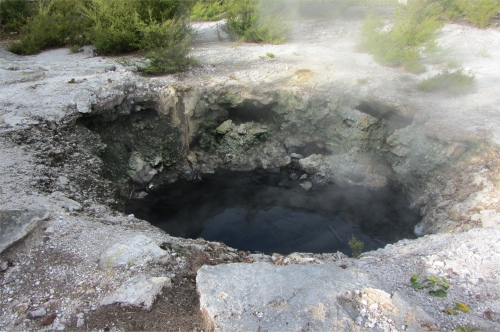They were spending a month in New Zealand trying to see as much as they could, on a tight budget. Good luck to them I thought.
"Did you hear the rain last night?" asked Jess, the shorter of the two. I looked around and the grass was soaking. I hadn't heard a thing. Unfortunately for the girls, the groundsheet of their tent acted like a sieve; not a good sign considering the weather was about to turn.
 The Blue Lake (Tikitapu) |
A brief history of the village follows. American missionaries reverend Seymour and Ellen Spencer arrived in New Zealand in 1842 and from 1845 worked with the Tuhourangi people from their homestead at Kariri (Galilee) beside Lake Tarawera. By the 1850s soil fertility has decreased, and with the influx of tourism to the Tarawera area, many Maori people drifted to the nearby village of Te Wairoa, where the settlement offered many attractions. Reverend Spencer and his family moved to Te Wairoa in 1852 and established a mission church at Te Mu to serve the expanding population.
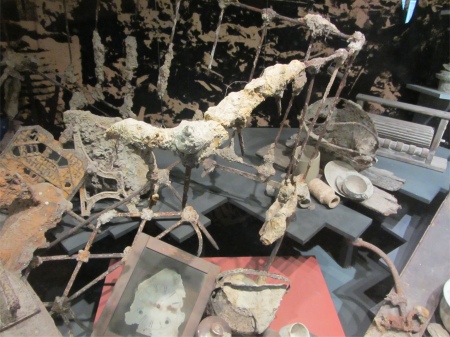 Excavated Artefacts form Te Wairoa School |
By the 1860s European clothing was more commonly worn and Maori people were occasionally building European style houses in place of the traditional raupo and bark whare. At the same time nearby tribes were becoming involved in land wars, and by 1865 garrisons were established throughout the district. Many Maori retreated to Kariri where there was a fortified pa.
Spencer's excursions were restricted and it became difficult to hold his congregation together. Many men were employed in road building and in the service of the Government, and some were involved in the land wars. By 1867 card playing, gambling and drinking were increasing. Mrs Spencer and her daughters left for the coast in March 1868 when the district was threatened with violence by a party led by Te Kooti, the feared warrior from the east. Spencer himself left the station at Te Wairoa in 1870 and the mission was never re-opened. The 25 years of mission work at Te Wairoa were over.
Te Wairoa with its two hotels became a favourite staging post for tourists who were on their way to see the marvels of the Pink and White Terraces; the "eighth wonder of the world". Local Maori would act as guides, and one even bought the rights to the terraces, enabling charges to be made for tourists travelling across the lake to see them, taking photographs or making sketches of them.
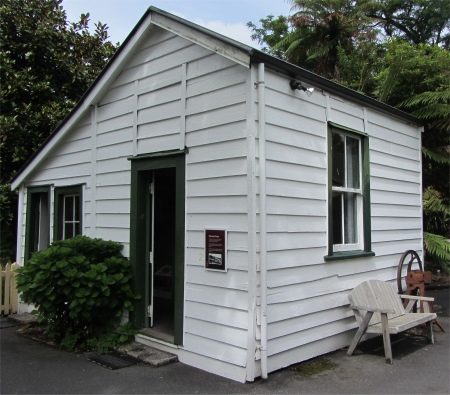 1860s Pit-sawn Rimu Pioneer House Moved From Ohinematu |
Everything was about to change for ever. The night of 9th June 1886 was cold and silent. Shortly after midnight, residents of Te Wairoa were woken by earthquakes. By 02:30 craters were erupting "lava" along an 8km rift extending north-eastward across Tarawera.
An immense black column of ash and smoke, 9.5km in height, rose from the direction of Tarawera. A freezing wind, electrical displays, fireballs, and a red glow were accompanied by rumbling and roaring.
By around 03:20, the eruption had spread southward to Rotomahana. Violent steam eruptions were produced when hot molten rock encountered surface and subsurface water. These explosions sent up ash and mud that covered much of the surrounding area.
Debris continued to fall until about 6am, when the day dawned on a devastated landscape. A 16km long rift extended across the mountain top from Tarawera and into what is now the Waimangu Valley.
Meanwhile, what of the Haszard family? On the eve of the eruption the family and their two guest surveyors, Blythe and Lundis, had observed a conjunction of Mars and the Moon. They were not long in bed when they were awakened by earthquakes. An electrical display was seen over Tarawera.
The group was soon joined by Mere Hamiora, who had been staying at the old mission house. Together they gathered in the drawing room, listening to a distant roaring and stones falling on the roof, and nervously watching the flames of the stove blown into the room by cold blasts of wind. Clara and Ina took turns playing the organ and singing hymns so that the small children would not be alarmed.
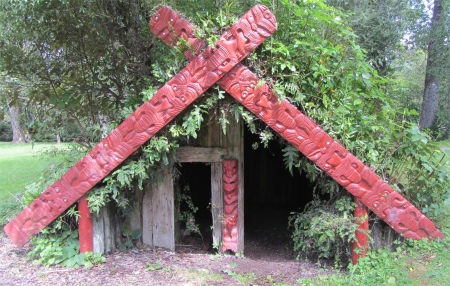 Tohunga's (priest) Whare |
"I wriggled the chair backwards towards the chiffonier. Just then a large beam fell down from the roof, striking my husband, and falling at one end at the spot where I had been sitting. The other end crashed down on the chiffonier, resting with agonising weight on my leg, and pinned me in a crouching position on my chair. The roar and din was awful all the time, and I couldn't move."
"Mona ..... cried to me to give her more room, as I was pressing her against the beam, but the load of volcanic mud pouring down on me prevented me from being able to render and assistance, and the child was crushed and smothered in my arms, and died."
"My little boy, who had been standing by me, said, "We can't live, can we?" and I replied, "No, dear, we will die together." He then said, "Jesus will come and take us," and I never heard his voice again. While the debris and mud were falling in, one of my little girls gave a glad cry of "papa", and spoke no more. All through the night, the roar of the volcano, the sound of falling mud, and the heat of the flames continued. I could not move or make anyone hear, and but for the corrugated iron on the building I'm sure I should have been burnt."
"Edna, I think, died shortly after Adolphus, as she said, "Oh, my head!" as the mud was bearing down on her, and she spoke no more ...... "
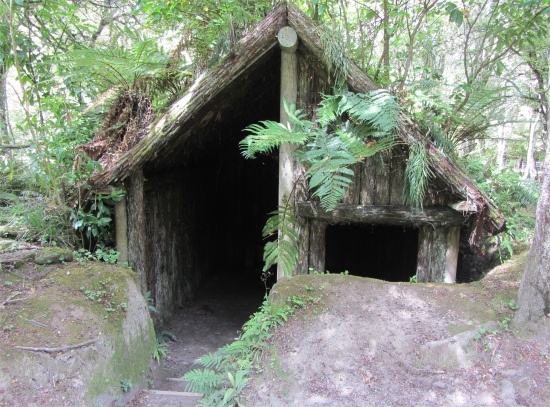 Whare Excavated in the Late 1930s |
A dripping, fern-draped short bush walk through the valley brought me to the Te Wairoa Falls, where the Wairoa River plunged 30m over rocky outcrops. The walk helped take my mind off the tragedy that had occurred here, and the personal account from Mrs Haszard, which I found rather haunting - to be trapped in a helpless position whilst your children die around you I find hard to contemplate.
I finished the walk as the heavens opened, and headed back to Rotorua, and parked up in the Government Gardens. I wanted to amble around the gardens, but more importantly I wished to visit the Rotorua Museum within the gardens.
The museum had an interesting set of displays and films which gave a good account of the town and its surroundings and its history plus an insight into the buildings former use as a bath house.
Rotorua is built entirely in the crater of a volcano, the distant skyline all around is the rim. The highly acidic, milky coloured water of Sulphur Bay lies on top of an active geothermal field. Each day about 80,000 tonnes of water flows out of the Rotorua geothermal field, of which about 28,000 tonnes per day up-flows directly into Lake Rotorua, most of this occurring in Sulphur Bay. The rocky outcrops and islands are sinter cemented lakebeds laid down during the past 9,000 years when the lake was 10-15m higher. These have become protected nesting places for red-billed, black backed and black-billed gulls. The whole of Sulphur Bay and parts of its shoreline is one of the few wildlife sanctuaries in the North Island. The oxygen-low water forces the birds to leave the area daily in search of food.
Lake Rotorua is the oldest continuously existent lake in New Zealand. It formed in the crater of a vast caldera left after a violent eruption some 220,000 years ago. Around 200 cubic kilometres of material was spewed over the surrounding land. From about 65,000 years ago to about 22,000 years ago the lake was 80m higher than today. This resulted from a huge volcanic eruption out of neighbouring Okataina volcano, which blocked the outlet of Lake Rotorua for more than 40,000 years.
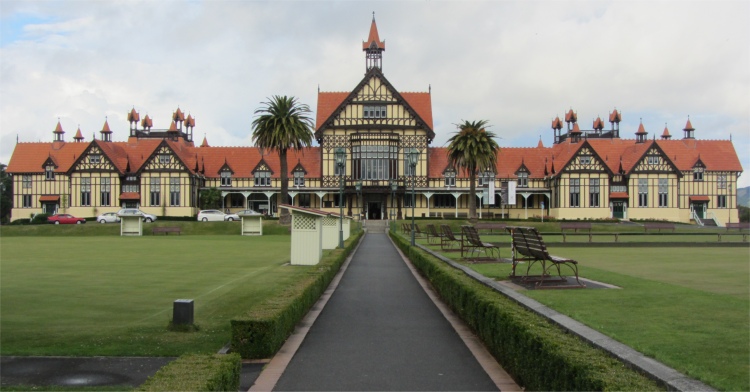 Rotorua Museum |
As for the building itself, the museum is housed in a structure with a romantic past. The Bath House building, which opened in 1908, was designed along the lines of European spas, and represents the New Zealand Government's first major investment in the tourism industry.


